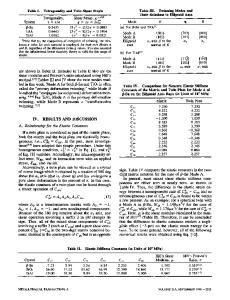Deformation twinning in hexagonal materials
- PDF / 1,109,111 Bytes
- 6 Pages / 585 x 783 pts Page_size
- 43 Downloads / 702 Views
roduction Materials such as Mg, Zr, and Ti with a hexagonal close-packed (hcp) structure are used in automotive, nuclear, aeronautic, and defense technologies, among others.1 The basic plasticity mechanisms associated with hcp structures are slip and twinning. The easiest dislocation slip is along the 1120 close-packed directions on the (0001) basal plane or {10 10} prismatic planes.2,3 These dislocations, however, do not generate deformation along the c-axis. The alternative mechanisms available for doing so are c + a slip on {10 11} pyramidal planes, tensile twins, or compressive twins where the twin planes vary with the material.3 The activation of pyramidal slip requires a higher critical resolved shear stress than that of the basal and prismatic slip. Thus, {10 12} 10 1 1 twinning, which has a critical resolved shear stress close to the basal slip, is an important mode for accommodating strain along the c-axis.4 The localized shear associated with twinning is partly the reason for the poor ductility and low deformability of Mg alloys.4 The current emphasis for advancing applications of hexagonal materials is to improve deformability while preserving a high flow strength. The fundamental principle is to adjust the relative activity among slip and twinning systems.5 Therefore, an in-depth understanding of mechanisms and mechanics of deformation twinning in hexagonal materials is essential.
}
Twinning in hexagonal materials is directional with a unique shear direction. Correspondingly, several specific characteristics are associated with hexagonal materials: (1) Rolled hexagonal metal plates exhibit a characteristic texture component with the crystal c-axis (the basal pole) preferentially aligned along the normal direction of the plates. (2) The flow-stress evolution shows strong anisotropy between the in-plane and throughthickness directions. (3) The in-plane flow stress is very different in tension from that in compression. Accompanying the reorientation of most grains by twinning, the aggregate shows an increase in hardening rate and continuous evolution of grain microstructure with deformation. Twin shear localizes in a defined domain of a grain. Twin nucleation in hexagonal materials is driven by local stress states and local atomistic configurations at grain boundaries (GBs).6,7 Twin growth, including propagation and thickening, is driven by long-range stress states across grains through the motion of twin boundaries (TBs), either by the gliding of twinning dislocations on the twin plane along the twinning direction (propagation) or migration of TBs normal to the twin plane (thickening) via nucleation and gliding of twinning dislocations on the twin plane. This motivated the study of structural characteristics of TBs and the pinning effect of solute atoms on the migration of TBs.8 Corresponding to the
Xiaozhou Liao, School of Aerospace, Mechanical and Mechatronic Engineering, The University of Sydney, Australia; [email protected] Jian Wang, Mechanical and Materials Engineering, University of Nebraska–L
Data Loading...











